The Diamond Quadrilateral Bullet Train Network Project is an ambitious initiative by the Government of India. This project aims to revolutionize the country’s railway system by connecting the four major metros—Delhi, Mumbai, Chennai, and Kolkata—with high-speed bullet trains.
What is the Diamond Quadrilateral Bullet Train Network?
The Diamond Quadrilateral Bullet Train Network is a high-speed rail project envisioned to create a quadrilateral of bullet train routes connecting India’s largest cities. This initiative aims to significantly reduce travel time, boost economic growth, and modernize the country’s transportation infrastructure.

Key Features:
- Objective: Connect Delhi, Mumbai, Chennai, and Kolkata with high-speed bullet trains.
- Speed: Trains running at speeds of up to 300 km/h or more.
- Routes: Forming a diamond-shaped quadrilateral connecting major metros.
- Launch Year: Announced in 2014 by Prime Minister Narendra Modi.
Historical Background
India’s railway system has been the backbone of the country’s transport network for over a century. However, with rapid economic growth and urbanization, there is a growing need for faster and more efficient rail transport. The Diamond Quadrilateral project addresses this need by introducing high-speed rail services.
Key Milestones:
- 2014: Announcement of the project by Prime Minister Narendra Modi.
- 2017: Feasibility studies and initial planning.
- Ongoing: Phased implementation and construction.
Engineering Challenges
Building a high-speed rail network in a country as vast and diverse as India presents numerous engineering challenges. These include acquiring land, ensuring safety, and integrating the new system with the existing rail infrastructure.
Solutions Implemented:
- Land Acquisition: Streamlined processes for acquiring land required for the project.
- Safety Standards: Implementation of global safety standards for high-speed rail.
- Infrastructure Integration: Developing systems to integrate the bullet train network with existing railways.
Strategic Importance
The Diamond Quadrilateral Bullet Train Network is strategically significant for India. It aims to enhance connectivity, reduce travel time, and spur economic development.
Key Benefits:
- Enhanced Connectivity: Seamless travel between major economic hubs.
- Reduced Travel Time: Significantly faster journeys compared to traditional rail.
- Economic Growth: Boost to trade, tourism, and regional development.
Technological Advancements
The project leverages cutting-edge technology to ensure efficiency, safety, and reliability.
Key Technologies:
- Advanced Train Systems: Use of state-of-the-art bullet train technology.
- Modern Infrastructure: High-quality tracks, stations, and support systems.
- Automation: Advanced signaling and control systems for smooth operations.
Environmental Considerations
The project incorporates sustainable practices to minimize environmental impact.
Environmental Measures:
- Green Construction: Use of eco-friendly materials and construction methods.
- Energy Efficiency: Design of energy-efficient trains and infrastructure.
- Environmental Protection: Measures to protect local ecosystems and wildlife.
The Diamond Quadrilateral Bullet Train Network Project represents a bold step towards transforming India’s railway system. By connecting major metros with high-speed trains, it promises to enhance connectivity, reduce travel time, and drive economic growth. This project is a testament to India’s commitment to building a modern, efficient, and sustainable transportation network.


59 comments
Thanks for sharing. I read many of your blog posts, cool, your blog is very good.
Your article helped me a lot, is there any more related content? Thanks!
Thinking about a loan against your home to consolidate your financial obligations? Find out more and check what options may be available to you.
Hello! Do you use Twitter? I’d like to follow you if that would be ok.
I’m absolutely enjoying your blog and look forward to new posts.
I like this post, enjoyed this one regards for posting.
Выигрывай реальные деньги в лучших казино! Обзоры слотов, бонусы, стратегии для победы! Подписывайся
Казино онлайн: фишки, стратегии, промокоды! Поднимись с нами! Реальные обзоры.
https://t.me/s/official_izzi/720
Выигрывай реальные деньги в онлайн казино! Обзоры слотов, бонусы, стратегии для победы! Присоединяйся
Игровые автоматы: фишки, стратегии, промокоды! Заработай с нами! Только честные обзоры.
https://t.me/Official_1win_1win/262
Погрузитесь в мир азарта с 7k casino! Вам предстоит увлекательные игры, щедрые бонусы и возможность сорвать куш! Попробуйте свои силы уже сегодня!
https://7k-off.online
https://t.me/s/official_monro
https://t.me/s/win1win777win
https://t.me/vavadaslot_777/362
https://t.me/s/wiwniwnwin
https://t.me/s/Rus_CasinoTop
https://t.me/s/win1Online1
https://t.me/s/Official_1win_1win
I discovered useful points from this.
Your point of view caught my eye and was very interesting. Thanks. I have a question for you.
I truly appreciated the manner this was laid out.
I’ll definitely recommend this.
I learned a lot from this.
I absolutely admired the way this was presented.
I took away a great deal from this.
I really liked the manner this was presented.
This is the kind of post I find helpful.
Thanks for publishing. It’s excellent.
I took away a great deal from this.
I truly admired the approach this was explained.
Thanks for posting. It’s top quality.
Thank you for your sharing. I am worried that I lack creative ideas. It is your article that makes me full of hope. Thank you. But, I have a question, can you help me?
I gained useful knowledge from this.
This is the kind of writing I truly appreciate.
Thanks for creating this. It’s top quality.
More posts like this would make the internet better.
I’ll gladly bookmark this page.
I particularly admired the approach this was laid out.
I’ll surely recommend this.
Thanks for creating this. It’s top quality.
Thanks for creating this. It’s brilliant work.
You’ve undoubtedly put in effort.
This is the kind of information I enjoy reading.
I found new insight from this.
I like the valuable info you provide in your articles. I will bookmark your weblog and check again here frequently. I am quite sure I will learn plenty of new stuff right here! Good luck for the next!
This submission is insightful.
I learned a lot from this.
I haven?¦t checked in here for a while since I thought it was getting boring, but the last few posts are great quality so I guess I will add you back to my daily bloglist. You deserve it my friend 🙂
I have been surfing online greater than three hours nowadays, yet I by no means discovered any fascinating article like yours. It’s pretty price sufficient for me. In my opinion, if all website owners and bloggers made excellent content material as you probably did, the internet will likely be much more useful than ever before. “I thank God for my handicaps, for through them, I have found myself, my work and my God.” by Hellen Keller.
Hey, you used to write magnificent, but the last several posts have been kinda boring… I miss your tremendous writings. Past few posts are just a little bit out of track! come on!
Hello there I am so excited I found your webpage, I really found you by mistake, while I was searching on Askjeeve for something else, Anyways I am here now and would just like to say thanks a lot for a remarkable post and a all round exciting blog (I also love the theme/design), I don’t have time to browse it all at the moment but I have saved it and also included your RSS feeds, so when I have time I will be back to read a great deal more, Please do keep up the awesome jo.
Limousine service near me
شركة سباكة بالدمام
https://t.me/s/Official_1win_TG/3001
Hello! I just would like to give a huge thumbs up for the great info you have here on this post. I will be coming back to your blog for more soon.
Very interesting points you have mentioned, thankyou for putting up. “In a great romance, each person plays a part the other really likes.” by Elizabeth Ashley.
I was just searching for this information for a while. After six hours of continuous Googleing, at last I got it in your site. I wonder what’s the lack of Google strategy that don’t rank this kind of informative web sites in top of the list. Generally the top sites are full of garbage.
Excellent goods from you, man. I’ve understand your stuff previous to and you are just extremely wonderful. I really like what you’ve acquired here, certainly like what you’re stating and the way in which you say it. You make it enjoyable and you still care for to keep it smart. I can not wait to read much more from you. This is really a tremendous website.
Elite cleaning service, great for busy Manhattan professionals. Booking for our entire building. Top shelf service.
very good put up, i definitely love this website, carry on it
Dry Cleaning in New York city by Sparkly Maid NYC
Thank you for your sharing. I am worried that I lack creative ideas. It is your article that makes me full of hope. Thank you. But, I have a question, can you help me? binance kód
Hello, you used to write magnificent, but the last several posts have been kinda boring?K I miss your super writings. Past several posts are just a little bit out of track! come on!